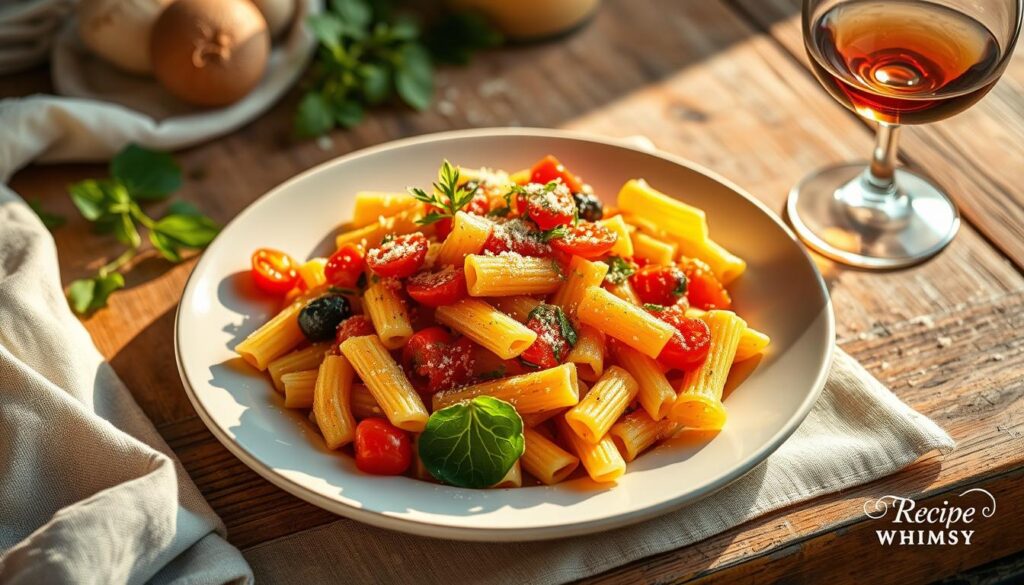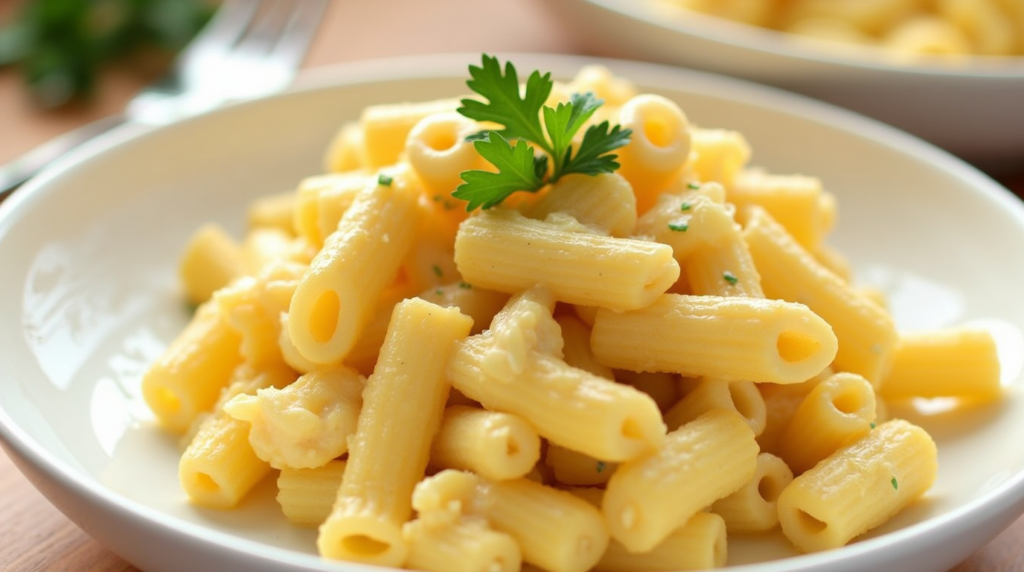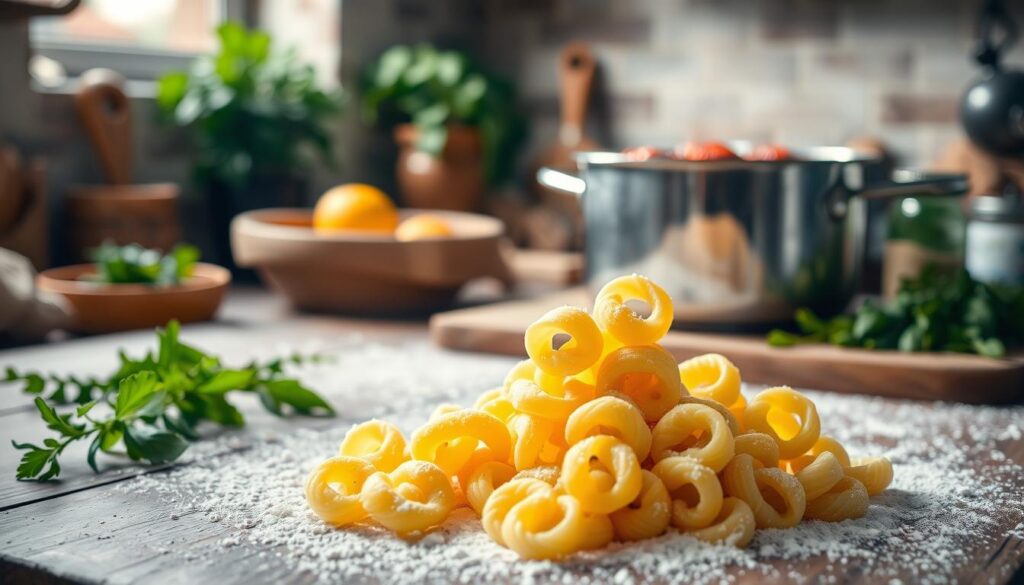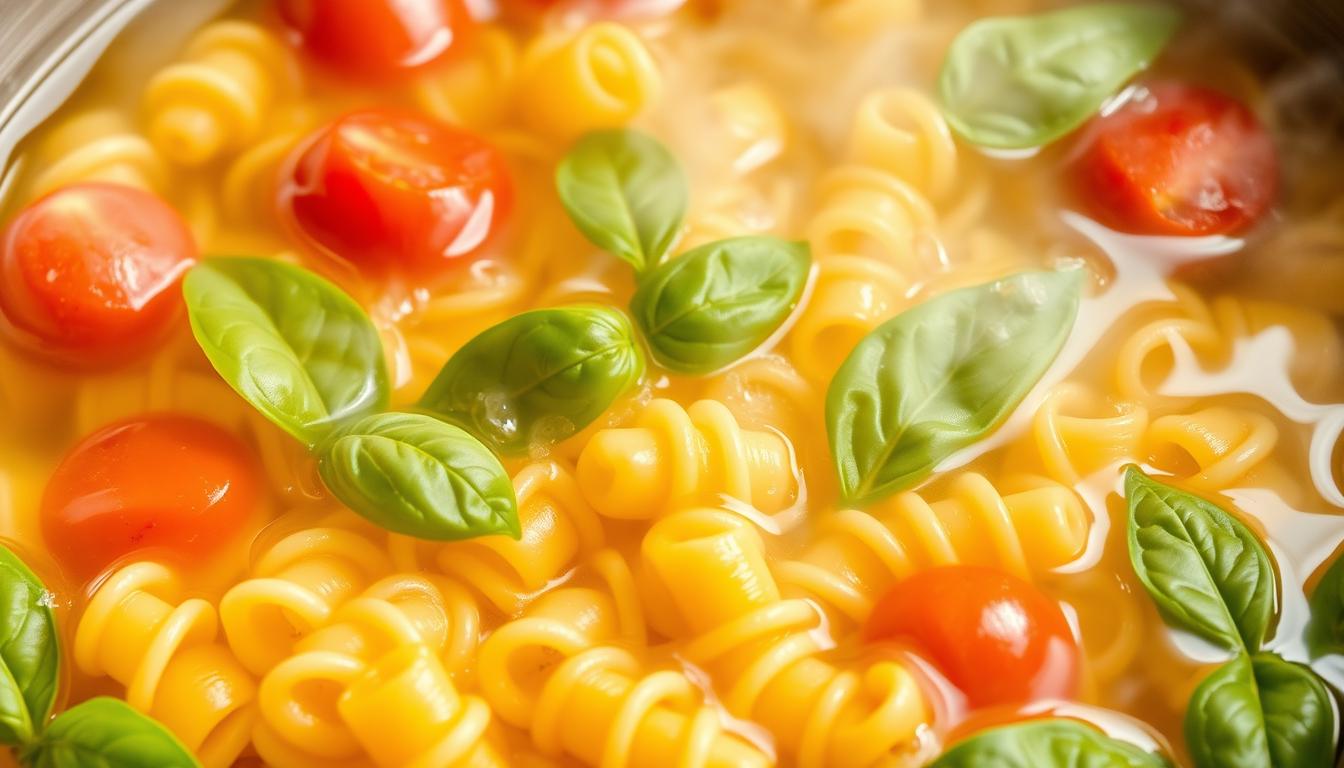When it comes to cooking cavatappi pasta, achieving the perfect texture can be a challenge. With its unique shape and versatility in dishes, cavatappi pasta has become a favorite among pasta lovers. To start, it’s crucial to understand the basics of cooking cavatappi pasta, including the right water-to-pasta ratio and cooking time. By following our simple, step-by-step guide, you’ll be able to achieve perfectly cooked cavatappi pasta every time, making it easy to create the best cavatappi recipe.
Cooking cavatappi pasta is an art that requires attention to detail, but with the right techniques, you can create delicious dishes that showcase the beauty of this pasta shape. Whether you’re a seasoned chef or a beginner in the kitchen, learning how to cook cavatappi pasta is a skill that will elevate your cooking and make you a master of the best cavatappi recipe.
Introduction to Cooking Cavatappi Pasta
In this article, you will learn the essential steps to cook cavatappi pasta to perfection, from the basics of cooking time to the importance of using the right sauce. With these tips and tricks, you’ll be able to create a variety of dishes that feature cavatappi pasta as the star ingredient, making it easy to enjoy the best cavatappi recipe.
Key Takeaways
- Understanding the right water-to-pasta ratio is crucial for cooking cavatappi pasta
- Cooking time plays a significant role in achieving the perfect texture
- Using the right sauce can elevate the flavor of cavatappi pasta
- Attention to detail is key when cooking cavatappi pasta
- Practice makes perfect when it comes to cooking cavatappi pasta
- Experimenting with different recipes can help you find the best cavatappi recipe
What is Cavatappi Pasta?
Cavatappi pasta is a type of Italian pasta known for its distinctive spiral shape, which resembles a corkscrew. This unique shape makes this pasta an excellent choice for dishes with thick sauces, as the sauce can cling to the pasta’s surface. You can find cavatappi pasta in various cavatappi pasta shapes, each with its own unique characteristics.
Origin and History of Cavatappi
Cavatappi pasta originated in Southern Italy, where it has been a staple in Italian cuisine for centuries. The name “cavatappi” translates to “corkscrew” in Italian, which describes its distinctive spiral shape. Understanding the origin and history of this pasta can help you appreciate its cultural significance and versatility in various recipes.
Unique Characteristics of Cavatappi
One of the unique characteristics of cavatappi pasta is its ability to hold onto thick sauces. The spiral shape of the pasta allows the sauce to cling to its surface, making each bite flavorful and satisfying. Whether you’re using this pasta in a classic Italian dish or a modern recipe, its unique characteristics make it an excellent choice for any meal.
Why Choose Cavatappi Pasta?
Cavatappi pasta is a popular choice among pasta lovers due to its unique characteristics and versatility in dishes. You can use it to create a wide range of cavatappi pasta dishes, from classic Italian recipes to modern fusion cuisine. With easy pasta recipes, you can create delicious and impressive meals that are sure to please your family and friends.
Versatility in Dishes
Cavatappi pasta is an excellent choice for various dishes, including salads, soups, and baked casseroles. Its spiral shape allows it to hold onto sauces and seasonings, making it a great addition to many recipes. Some popular cavatappi pasta dishes include cavatappi with pesto and cherry tomatoes, cavatappi mac and cheese, and cavatappi with sausage and peppers.
Excellent Sauce Gripping Ability
One of the primary advantages of cavatappi pasta is its excellent sauce gripping ability. The spiral shape of the pasta allows the sauce to cling to its surface, resulting in a more flavorful and satisfying meal. This makes it an ideal choice for easy cavatappi pasta recipes that require a good sauce-to-pasta ratio. You can try pairing cavatappi with your favorite sauces, such as marinara, alfredo, or carbonara, for a delicious and satisfying meal.
Essential Cooking Tools for Cavatappi
To cook cavatappi pasta perfectly, you’ll need the right cooking tools. A large pot with a heavy bottom is essential for cooking pasta, as it allows for even heat distribution and prevents the pasta from sticking to the bottom. This is a crucial cavatappi pasta cooking tip to keep in mind.
When it comes to homemade cavatappi pasta, having the right tools can make all the difference. Here are some key tools to consider:
- A large pot with a heavy bottom
- A good colander for draining excess water
- A wooden spoon or silicone spatula for stirring and serving
- A pasta machine or sharp knife for shaping homemade cavatappi pasta
Using these tools, you’ll be well on your way to creating delicious cavatappi pasta dishes with ease. Remember to always follow proper cavatappi pasta cooking tips to ensure the best results.
By investing in these essential cooking tools, you’ll be able to cook cavatappi pasta like a pro and enjoy a variety of delicious dishes. Whether you’re making homemade cavatappi pasta or cooking store-bought pasta, having the right tools on hand is essential for achieving perfect results.
| Tool | Description |
|---|---|
| Large Pot | Essential for cooking pasta, allows for even heat distribution |
| Colander | Crucial for draining excess water, prevents pasta from becoming mushy |
| Wooden Spoon or Silicone Spatula | Helpful for stirring and serving, prevents pasta from breaking or sticking |
The Perfect Cavatappi Recipe
To create a delicious and satisfying meal, you’ll need to follow a few simple steps. The best cavatappi recipe starts with high-quality cavatappi pasta, which can be found at most Italian markets or online. When it comes to cavatappi pasta cooking tips, it’s essential to use the right amount of water and to not overcook the pasta.
Here are the ingredients you’ll need for the perfect cavatappi recipe:
- 1 pound cavatappi pasta
- 2 tablespoons olive oil
- 3 cloves garlic, minced
- 1 cup your favorite sauce
Step-by-Step Cooking Instructions
Follow these easy steps to cook cavatappi pasta to perfection:
- Bring a large pot of salted water to a boil
- Add the cavatappi pasta and cook for 8-10 minutes, or until al dente
- Drain the pasta and set it aside
- Heat the olive oil in a large skillet over medium heat
- Add the garlic and cook for 1-2 minutes, or until fragrant
- Add the sauce and cook for 2-3 minutes, or until heated through
- Combine the cooked cavatappi pasta and sauce, and serve hot
By following these simple steps and using the best cavatappi recipe, you’ll be able to create a mouth-watering meal that’s sure to impress your family and friends. Remember to always use cavatappi pasta cooking tips to ensure that your dish turns out delicious and satisfying.

With this recipe, you’ll be able to enjoy a delicious and satisfying meal that’s perfect for any occasion. Whether you’re cooking for yourself or for a crowd, the best cavatappi recipe is sure to please.
| Ingredient | Quantity |
|---|---|
| Cavatappi pasta | 1 pound |
| Olive oil | 2 tablespoons |
| Garlic | 3 cloves |
| Sauce | 1 cup |
Tips for Cooking Cavatappi Pasta
Cooking cavatappi pasta requires attention to detail to achieve the perfect texture and flavor. When preparing cavatappi pasta dishes, it’s essential to use the right amount of water. The ideal water-to-pasta ratio is between 4-6 quarts of water for every pound of cavatappi pasta.
Adding salt to the pasta water is also crucial, as it helps to season the cavatappi pasta and improve its texture. To cook cavatappi pasta perfectly, follow these tips:
- Use a large pot to allow for even cooking and to prevent the cavatappi pasta from becoming tangled.
- Bring the salted water to a boil before adding the cavatappi pasta.
- Stir the cavatappi pasta occasionally to prevent it from sticking together.
By following these tips, you’ll be able to create delicious cavatappi pasta dishes that are full of flavor and have the perfect texture. Whether you’re making a simple cavatappi pasta dish or a more complex recipe, these tips will help you to achieve the best results.
How to Achieve Al Dente Cavatappi
Achieving the perfect al dente texture is crucial when cooking cavatappi pasta. To do this, you need to understand what al dente means – it should be firm to the bite but not hard or crunchy. With our easy cavatappi pasta recipes, you can create delicious meals that are sure to please your family and friends.
Timing is everything when it comes to cooking cavatappi pasta shapes. If you overcook it, the pasta will become mushy and unappetizing. On the other hand, undercooking it can result in a hard or crunchy texture. To get it just right, follow these tips:
Understanding Al Dente Texture
Al dente texture is all about finding the perfect balance between firmness and softness. When you bite into a perfectly cooked cavatappi pasta, it should have a slight resistance to it, but still be easy to chew. This texture is achieved by cooking the pasta for the right amount of time, which can vary depending on the specific type of cavatappi pasta you are using.
Timing Your Cooking Process
To achieve the perfect al dente texture, you need to time your cooking process carefully. Here are some general guidelines to follow:
- Bring a large pot of salted water to a boil
- Add the cavatappi pasta and cook for 8-10 minutes, or according to the package instructions
- Check the pasta regularly to avoid overcooking
By following these tips and using our easy cavatappi pasta recipes, you can create delicious and satisfying meals that are sure to please your family and friends. Whether you’re a seasoned chef or a beginner in the kitchen, mastering the art of cooking cavatappi pasta shapes is a skill that will serve you well in your culinary journey.
Cavatappi Pasta Serving Suggestions
When it comes to serving cavatappi pasta, the options are endless. You can pair it with a wide range of sauces, from classic tomato sauce to creamy pesto. To find the perfect cavatappi pasta for your dish, you can search for where to buy cavatappi pasta online or visit your local Italian market.
Pairing with Sauces
Cavatappi pasta is a versatile ingredient that can be paired with various sauces to create a delicious and satisfying meal. Some popular sauce options include:
- Tomato sauce with fresh basil and mozzarella cheese
- Creamy pesto with cherry tomatoes and grilled chicken
- Carbonara sauce with bacon and parmesan cheese
Adding Proteins and Vegetables
To add some extra flavor and nutrition to your cavatappi pasta dish, you can include a variety of proteins and vegetables. Some popular options include:
- Grilled chicken or shrimp with roasted vegetables
- Sauteed spinach and mushrooms with garlic and lemon
- Roasted bell peppers and zucchini with olive oil and herbs
By experimenting with different sauces, proteins, and vegetables, you can create a unique and delicious cavatappi pasta dish that suits your taste and dietary preferences. So, go ahead and get creative with your cavatappi pasta, and don’t forget to check where to buy cavatappi pasta for the best quality and variety.
Storing Leftover Cavatappi
When you’ve cooked a delicious batch of homemade cavatappi pasta, it’s essential to store any leftovers properly to maintain their freshness and quality. This is particularly important for cavatappi pasta cooking tips, as the right storage techniques can make a significant difference in the pasta’s texture and flavor.
To store leftover cavatappi, start by cooling it to room temperature. This helps prevent the growth of bacteria and keeps the pasta fresh. Once cooled, transfer the cavatappi to an airtight container, making sure to seal it tightly to prevent air from entering. Refrigerate the container within two hours of cooking, and your leftover cavatappi will remain fresh for a longer period.
Best Practices for Refrigeration
Some best practices for refrigerating leftover cavatappi include:
- Using a shallow container to cool the pasta quickly
- Labeling the container with the date and contents
- Storing the container in the coldest part of the refrigerator
Reheating Tips for Optimal Texture
When reheating leftover cavatappi, it’s crucial to use the right technique to achieve the optimal texture. Some tips include:
- Reheating the pasta in the microwave with a small amount of water or sauce
- Stirring the pasta frequently to prevent it from becoming mushy
- Adding a small amount of olive oil to the pasta to prevent it from sticking together

By following these tips and best practices, you’ll be able to enjoy your leftover homemade cavatappi pasta without sacrificing its flavor or texture. Remember to always prioritize proper storage and reheating techniques to get the most out of your cavatappi pasta cooking tips.
| Storage Method | Shelf Life |
|---|---|
| Airtight container in the refrigerator | 3-5 days |
| Freezer-safe bag or container | 2-3 months |
Creative Cavatappi Dishes to Try
When it comes to cavatappi pasta dishes, the possibilities are endless. With the right ingredients and a bit of creativity, you can create a variety of delicious meals that are sure to impress. One popular option is to use cavatappi in a mac and cheese dish, combining the creamy texture of macaroni and cheese with the unique shape of cavatappi pasta.
Another great idea is to pair cavatappi with pesto and cherry tomatoes, showcasing the pasta’s ability to pair well with light and flavorful sauces. To make the most of these dishes, it’s essential to have a good understanding of the best cavatappi recipe. By following a few simple steps and using high-quality ingredients, you can create a variety of cavatappi pasta dishes that are both delicious and visually appealing.
Cavatappi Mac and Cheese
This classic comfort food gets a twist with the use of cavatappi pasta. The corkscrew shape of the pasta holds onto the cheesy sauce perfectly, making each bite a satisfying one.
Cavatappi with Pesto and Cherry Tomatoes
This light and flavorful dish is perfect for a summer evening. The pesto sauce coats the cavatappi pasta nicely, while the cherry tomatoes add a burst of freshness to each bite.
With these creative cavatappi dishes, you can take your pasta game to the next level. Whether you’re in the mood for something comforting and creamy or light and flavorful, there’s a cavatappi recipe out there for you. So go ahead, get creative, and start experimenting with different cavatappi pasta dishes today!
Troubleshooting Common Cavatappi Issues
Even with the best intentions and easy cavatappi pasta recipes, common issues can arise when cooking cavatappi pasta. Overcooking or clumping can be frustrating, but there are ways to troubleshoot these problems.
To rescue overcooked cavatappi pasta, try adding a small amount of water or sauce to revive its texture. This simple trick can make a big difference in the final dish.
Overcooked Cavatappi: What to Do
Overcooking can be a common mistake, especially for beginners. To avoid this, it’s essential to monitor the cooking time and check the pasta regularly. If you do end up with overcooked cavatappi, don’t worry – it’s not the end of the world.
Fixing Clumpy Pasta
Clumpy pasta can be fixed by stirring the pasta gently and adding a small amount of oil to prevent sticking. This will help to separate the pasta and create a more even texture.

By following these simple tips and using easy cavatappi pasta recipes, you’ll be able to create delicious and satisfying meals that are sure to please your family and friends. With a little practice and patience, you’ll become a master of cooking cavatappi pasta in no time.
Health Benefits of Cavatappi Pasta
Cavatappi pasta is a nutritious and delicious addition to a balanced diet. With its unique cavatappi pasta shapes, it provides a good amount of carbohydrates, fiber, and protein. By following cavatappi pasta cooking tips, you can create healthy and satisfying meals that are sure to please your family and friends.
Some of the key health benefits of cavatappi pasta include:
- High fiber content, which can help lower cholesterol levels and promote digestive health
- Good source of protein, making it an excellent option for vegetarians and vegans
- Rich in complex carbohydrates, providing sustained energy and supporting healthy blood sugar levels
For those looking for an even healthier option, whole grain cavatappi pasta is a great choice. It offers more fiber and nutrients compared to traditional cavatappi pasta. By incorporating cavatappi pasta cooking tips into your meal preparation, you can enjoy the nutritional benefits of cavatappi pasta while also exploring new and exciting recipes.
Overall, cavatappi pasta is a versatile and nutritious food that can be enjoyed in a variety of dishes. With its unique cavatappi pasta shapes and numerous health benefits, it’s an excellent addition to a balanced diet. By following cavatappi pasta cooking tips and choosing whole grain options, you can create delicious and healthy meals that are sure to please.
Frequently Asked Questions About Cavatappi Pasta
As you’ve explored the wonderful world ofcavatappi pasta, you may have some lingering questions. Let’s address a few of the most common inquiries to ensure you have all the information you need to confidently incorporate this versatile pasta into your culinary repertoire.
Can You Use Cavatappi in Baked Dishes?
Absolutely!Cavatappi pasta is an excellent choice for baked dishes, such as casseroles and pasta bakes. Its unique corkscrew shape allows it to hold onto sauces and fillings exceptionally well, making it a perfect fit for these types of recipes. Feel free to experiment with bakingcavatappiin your favorite cheesy, saucy, or vegetable-packed dishes.
How Long Can You Store Cooked Cavatappi?
Proper storage is key to enjoying your leftovercavatappi pasta. When stored properly in an airtight container in the refrigerator, cookedcavatappican last for 3-5 days. Be sure to refrigerate the pasta within 2 hours of cooking for optimum freshness and food safety. When you’re ready to enjoy your leftovercavatappi, simply reheat it on the stovetop or in the microwave until heated through.
Whether youbuy cavatappi pastafrom your local grocery store or make it homemade, this versatile and delicious pasta is sure to become a staple in your kitchen. Experiment with new recipes and techniques to discover all the ways you can incorporatecavatappiinto your meals.
FAQ
Can You Use Cavatappi in Baked Dishes?
Yes, you can use cavatappi in baked dishes, such as casseroles or pasta bakes, where it adds a unique texture and flavor.
How Long Can You Store Cooked Cavatappi?
When it comes to storing cooked cavatappi pasta, it’s essential to follow proper food safety guidelines to ensure that the pasta remains fresh and safe to eat. By storing cooked cavatappi pasta in an airtight container and refrigerating it within two hours of cooking, you can enjoy your leftover pasta for several days.
Where Can I Buy Cavatappi Pasta?
Whether you buy cavatappi pasta at a store or make it homemade, you can find it at most Italian markets or online retailers.
How Do I Make Homemade Cavatappi Pasta?
For those interested in making homemade cavatappi pasta, a pasta machine or a sharp knife can be useful tools for shaping the pasta.
What Are the Nutritional Benefits of Cavatappi Pasta?
Cavatappi pasta is not only delicious but also nutritious, providing a range of health benefits when consumed as part of a balanced diet. The nutritional value of cavatappi pasta includes a good amount of carbohydrates, fiber, and protein. Whole grain cavatappi options are also available, which offer even more nutritional benefits, including higher fiber and nutrient content.

